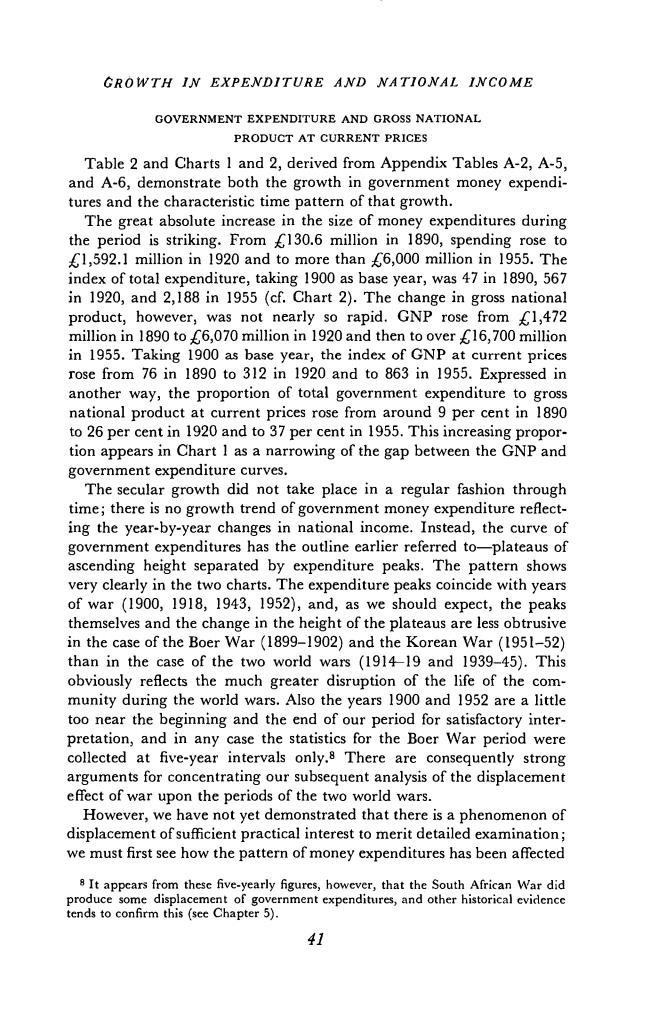正在加载图片...

GROWTH IN EXPENDITURE AND NATIONAL INCOME GOVERNMENT EXPENDITURE AND GROSS NATIONAL PRODUCT AT CURRENT PRICE Table 2 and Charts 1 and 2,derived from Appendix Tables A-2,A-5 and A-6,demonstrate both the growth in government money expendi tures and the characteristic time pattern of that growth. The great absolute increase in the size of money expenditures during the period is striking.From 130.6 million in 1890,spending rose to ,592.1 million in 1920 and to more million n5.The lex of total e enditur 1900 as bas year,was 47 in 1890,567 in 1920,and 2,188 in 1955 (cf.Chart 2).The change in gross nationa product,however,was not nearly so rapid.GNP rose from C1,472 million in 1890 to C6,070 million in 1920 and then to over 16,700 million in 1955.Taking 1900 as base year,the index of GNP at current prices rose from 76 in 1890 to 312 in 1920 and to 863 in 1955.Expressed in ar the way the proportion o total government expenditure to gros national product at current prices rose from around 9 per cent in 1890 to 26 per cent in 1920 and to 37 per cent in 1955.This increasing propor- tion appears in Chart I as a narrowing of the gap between the GNP and government expenditure curves. The rgrowth did not take place inaregular fashion through time;thereis no growth trend of governn ent money exper ure refect. ing the year-by-year changes in national income.Instead,the curve of government expenditures has the outline earlier referred to-plateaus of ascending height separated by expenditure peaks.The pattern shows very clearly in the two charts.The expenditure peaks coincide with years of war (1900,1918,1943,1952),and,as we should exp ct.the selves and the th. ht of th eaus are ess ob in the case of the or War-192)and the Korcan W ar(195l-52) than in the case of the two world wars (1914-19 and 1939-45).This obviously refects the much greater disruption of the life of the com- munity during the world wars.Also the vears 1900 and 1952 are a little too ear the beginni ng and the end of ou riod for satisfactory inter pretation,ar in any case the statistics for the Boer War peric were collected at five-year intervals only.8 There are consequently strong arguments for concentrating our subsequent analysis of the displacement effect of war upon the periods of the two world wars However.we have not vet demonstrated that there is a phenomenon of displacement of sufficient practical interest tom rit detailed e we must first see how the pattern of money expenditures has been affected 8 It appears from these five-yearly figures,howe r,that the South African War did e5 rnment expenditures,and other historical evidence 花CR0 WTH LV EXPENDITURE AND NATIONAL INCOME GOVERNMENT EXPENDITURE AND GROSS NATIONAL PRODUCT AT CURRENT PRICES Table 2 and Charts 1 and 2, derived from Appendix Tables A-2, A-5, and A-6, demonstrate both the growth in government money expenditures and the characteristic time pattern of that growth. The great absolute increase in the size of money expenditures during the period is striking. From £130.6 million in 1890, spending rose to £1,592.1 million in 1920 and to more than £6,000 million in 1955. The index of total expenditure, taking 1900 as base year, was 47 in 1890, 567 in 1920, and 2,188 in 1955 (cf. Chart 2). The change in gross national product, however, was not nearly so rapid. GNP rose from £1,472 million in 1890 to £6,070 million in 1920 and then to over £16,700 million in 1955. Taking 1900 as base year, the index of GNP at current prices rose from 76 in 1890 to 312 in 1920 and to 863 in 1955. Expressed in another way, the proportion of total government expenditure to gross national product at current prices rose from around 9 per cent in 1890 to 26 per cent in 1920 and to 37 per cent in 1955. This increasing proportion appears in Chart 1 as a narrowing of the gap between the GNP and government expenditure curves. The secular growth did not take place in a regular fashion through time; there is no growth trend of government money expenditure reflecting the year-by-year changes in national income. Instead, the curve of government expenditures has the outline earlier referred to—plateaus of ascending height separated by expenditure peaks. The pattern shows very clearly in the two charts. The expenditure peaks coincide with years of war (1900, 1918, 1943, 1952), and, as we should expect, the peaks themselves and the change in the height of the plateaus are less obtrusive in the case of the Boer War (1899—1902) and the Korean War (1951—52) than in the case of the two world wars (1914—19 and 1939—45). This obviously reflects the much greater disruption of the life of the community during the world wars. Also the years 1900 and 1952 are a little too near the beginning and the end of our period for satisfactory interpretation, and in any case the statistics for the Boer War period were collected at five-year intervals only.8 There are consequently strong arguments for concentrating our subsequent analysis of the displacement effect of war upon the periods of the two world wars. However, we have not yet demonstrated that there is a phenomenon of displacement of sufficient practical interest to merit detailed examination; we must first see how the pattern of money expenditures has been affected 8 It appears from these live-yearly figures, however, that the South African War did produce some displacement of government expenditures, and other historical evidence tends to confirm this (see Chapter 5). 41